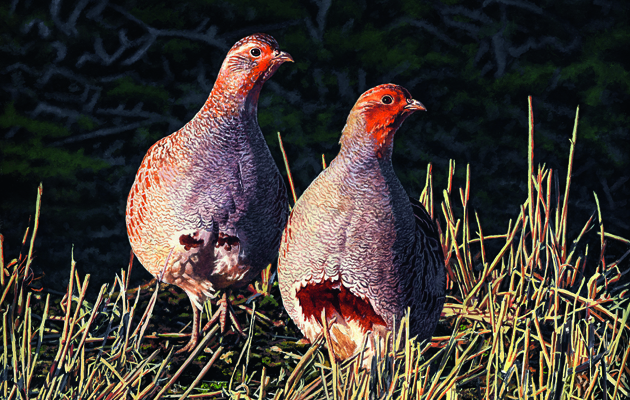Jason Lowes spent his childhood in the north Pennines and summers beating on the moors. He has an enduring love of both the gamebirds and the landscape.
Jason Lowes is based in County Durham. The watercolourist’s sporting art teems with coveys of grouse or partridges but what really draws you into his evocative work is the quality of his landscapes. Heather in bloom on a low horizon blurs to grey; autumn sunshine strikes a copper glow from dying bracken – it’s clear the man has lived on these moors all his life, although he has never been grouse shooting.
“I’ve been here in Stanhope for the past 12 years and, before that, I lived for 29 years in a little village not far from here called Rookhope. I was brought up with the grouse moors, they were always there on the tops of the hills surrounding my home” says Jason Lowes.
Although his father wasn’t involved in keepering, Lowes’ older brothers and sisters all went beating and as a teenager he relied on beating for summer holiday work. “I think my parents were quite glad because it kept me out of trouble. After five days in a row of beating you are far too exhausted to think of doing anything apart from sleeping,” Lowes admits.
“At that stage I didn’t have the love of the grouse that I do now. I was into the moors and the wildlife generally. My favourite moor is Reeth, where the Nickersons have their shoot. But all the moors have their own individual topography and characteristics that make them special.
“When you are painting a grouse moor you need to get those particular landmarks right, a rocky outcrop or a burn, otherwise a moor can look a bit nondescript. For me, the light is really special. On a breezy, showery day you get these dramatic cloud formations where half the moor is in deep shadow and the other half bathed in sunlight. Of course, they look very pretty in the snow but I think the best time of all is in the late season, in October or November, with the sun very low on those last couple of drives and you get an orange glow, which is very atmospheric.
I have a print called November Grouse – I was out on a day late on and there were these wonderful russet colours. The season only lasts a few months, yet the landscape changes so quickly from month to month.”
Sporting artist Jason Lowes studied graphic design at college but “did ‘normal’ jobs for the first 10 years and ended up working in a place that produced decorative lead crystal figurines. Their designer retired and they knew I painted a bit and I wanted to try it, so they let me have a go and I ended up sculpting the designs.”
But the company went into receivership, leaving Jason Lowes, who was recovering from a car accident at the time, out of a job.
“It is not the easiest thing to jump into being an artist, with all the naysayers who are convinced you won’t make it. As with anything creative, you more or less have to be self-employed. When you’ve been used to having a good job, the whole thing feels a bit risky but I decided to have a go at it. And 14 years later, here I am.”
Starting out was tough, although a £50 enterprise allowance did at least cover his sandwich money. “It was a bit daunting but I did the rounds of the agricultural and country fairs and the commissions started trickling in.”
Shoot and moor owners love the fact that Jason Lowes’ paintings have the painstaking detail you would expect from a leading wildlife artist, combined with a sense of place that makes them very personal. “I think any artist who paints gamebirds cannot help but be influenced by Rodger McPhail and, of course, Archibald Thorburn. I am always out and about with the binoculars observing and getting photographs. Every painting reflects all the different aspects and knowledge of the landscape. I am doing a partridge painting now and there are more than a dozen different photographs going into it, as well as all the detail.
But grouse remain Lowes’ first love. “I have never shot but when you are there on the moor on a day and you see the first lot of birds after such a long wait, it is amazing. You never tire of it. I still watch them all through the winter and then into the spring with their chicks.”





